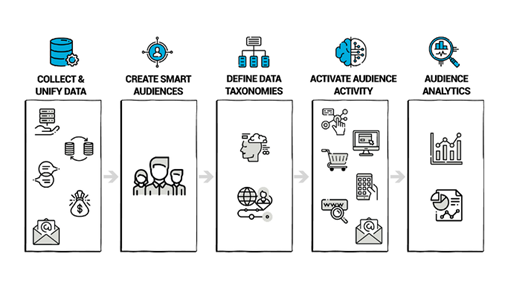Don't panic! I'm here to help. You should build it. Wait, no no, no. You should buy it. Wait, you should build AND buy it. Hold on. I don't know. I don't know! Help! Help!

Okay, let's all take a second to calm down. We can figure this out step by step. Together. Have you taken some deep breaths? Then, it's time to begin.
73% of companies report that a CDP is critical to their customer experience effort. Plus, 47% of respondents reported that they will increase their CDP budget by more than 25% in the next five years. But how should you be investing?
But first up, some definitions.
What is a Customer Data Platform, or CDP?
A customer data platform, or CDP for all you cool cats, is a centralised data infrastructure that clumps together a company's customer data, in order to build customer profiles and optimise customer engagement. According to the CDP institute - which has CDP in the name, so must be right - defines a Customer Data Platform as "packaged software that creates a persistent, unified customer database that is accessible to other systems." Put into English, it's a centralised system of customer data, made readily available to you and your teams.
So, a CDP is a software that aggregates and organises customer data, across a variety of touchpoints. They also collect and structure real-time data into individual, centralised customer profiles.
Customer Data Platforms...help companies solve a huge and growing problem: the need for unified, accessible customer data. Like most packaged software, a CDP reduces risk, deploys faster, costs less, and delivers a more powerful solution than custom-built alternatives."
— David Raab, Customer Data Platform Institute
These customer profiles are informed by a collage of first, second, and third party sources. This might include your; CRM, DMP, web forms, email, website, social media activity, behavioural data, transactional systems, and beyond.

How much does a customer data platform cost?
If you are marketing to a substantial number of people and you want to exploit any kind of automation or sophisticated tactics, you are notionally using some kind of a CDP,” It’s about automation at scale, and the question is “how much you’re willing to invest in doing that very, very well versus getting by with rudimentary tools.”
- Nick Rockwell, SVP of Engineering, Fastly
Let's look at the two options side by side.
The cost of building a CDP comes from:
- Hiring specialist team members. Investing in the full range of IT development roles, and large development teams
- Maintenance. The cost to run and maintain a CDP in-house can be high.
- Time to market restraints. Release timings can be slow, due to the dependence on the in-house team for any new feature.
- BUT the upfront costs will be less, as there is no subscription fee involved.

The cost of buying a CDP comes from:
- The cost of subscription. The cost of subscription will be charged, when buying a CDP platform.
- BUT the total cost of ownership is lower, as you will be paying monthly or yearly
- Time to market constraints will be fewer, as release timings can be accelerated, thanks to ready-to-deploy and an experienced provider
- IT and marketing support will be readily available.
So, if you're going on costs alone, buying a CDP is king. But before you make any rash decisions, let's look into it a little deeper, see what's right for you.
How do I choose a CDP?
There's a few things you have to consider before you go ahead and buy a CDP. Most of all, you've got to consider what you need from your vendor. Any deal breakers? Time to swipe left. So, you should ask yourself:
- Is the CDP able to process data, from a number of sources?
- Can it suggest personalised engagement strategies
- Can it create a useful, shareable database?
- Does it segment customers?
- Does it create a single customer view?
- Is it integrated into a delivery system?
So, now you've considered where a vendor falls in your company's needs. But let's have a further look into the pros and cons of buying.

Cons of buying a CDP
The good thing about buying a CDP is that it will do exactly what it says on the tin. The bad thing about bought CDPs is they do exactly what they say on the tin. So it's important to see what your company needs from the platform before buying something that doesn't stretch quite far enough. Cons can include:
- The purchased system not performing as needed. This means being unable to evolve to meet future plans, or even the risk of it being discontinued when a developer runs into personal business problems. It is vital that you consider the best vendor for you. So this also means:
- Vendor dependency can be tricky. Not only tricky, but lengthy. The decision of which vendor to choose can determine the future of your CDP.
- Maintenance can be an issue. A build solution, compared to bought, means you can perform maintenance at times that suit you and your customers. Plus, you'll not have to rely on the quality of maintenance coming from your vendor.
- The cost of building is reducing, thanks to tools improving. So if a company has the resources, it's likely they'll turn to building.
Pros of buying a CDP
Bought CDPs are often oven-ready, good-to-go products, making their convenience the biggest pull. Plus:
- Bought CDPs are more likely to deliver a broader set of features from the start.
- They will have a library of prebuilt connectors for output systems, saving considerable effort
- They are inherently flexible. If a major development project is needed, bought CDPs can step in. They require less development effort than built.
- It can take only 3-4 weeks from decision to implementation. If you need a CDP immediately, buying a ready-made one is the way to go.
- If the project is not up to scratch, you can contact the service provider. Not something you can do when the service provider is, well, you.
- Gartner even suggests that, if a commercial solution can meet 80% of your requirements, you should consider saving yourself a lot of time and effort by going with a buy.
But let's have a look into the other side.
How do you build a customer data platform?
Personalisation, personalisation, personalisation. That's what a built CDP offers you. And freedom, freedom too. Think: I'm a lone ranger in a cabin in the woods, I can build my farm exactly how I want. Wait, these logs aren't big enough. Woah, I've got to go and cut down the trees myself?!This is exhausting. But, boy oh boy, I can put up this windmill without even a smidgen of planning permission. Let's see if built will work for you.

If you can decide what needs your company has, you could probably make a really good case for building a CDP. You'll need access to your company's data warehouse or lake to build it on, plus a way to clean and enrich the data so it is compressed from a variety of different formats into one single format.
Plus, you'll need to involve not only your data scientists and analysts, development, maintenance, and IT, but your marketing team too. The CDP is being built for them, after all.
Cons of building a CDP
- Engineering resources are a finite commodity. Do you have the time and resources to build and maintain a CDP?
- There's a risk of tech being outdated. If a user needs to make a change, or connect a new marketing engine, they'll need to go through IT. With a bought system, this will be taken care of by the vendor.
- Additional expenses will be needed in order to maintain the system. So, even after saving money by building in the first place, chances are costs will be upped in the long term.
Pros of building a CDP
- A built system only adds features that are not already available in existing systems, so there might be the potential that the redundancy risk is lowered, when compared with a purchased system.
- The quality of the features delivered will be dictated by you. This means delivering everything you want it to, to a standard that you need, without vendor restrictions.
- You have complete control over customer engagement features, so the engagement boost might be pretty impressive.
- You'll be able to set the metrics you need to improve, in order to get a lead over your competitors.
- Talking about competitors - a built CDP offers you the opportunity, if you have the expertise, to get ahead. A bought CDP can only bring you up to the same level, with everyone having access to the same features and advantages.

